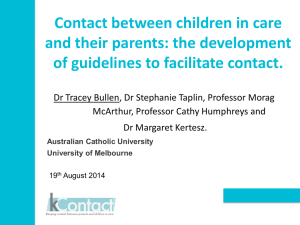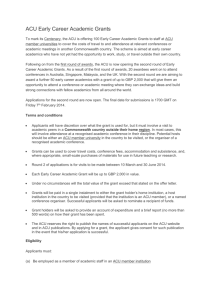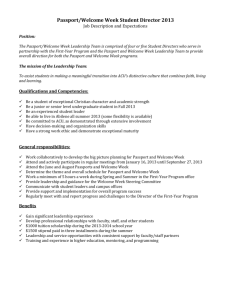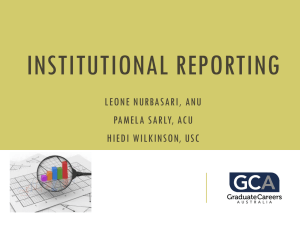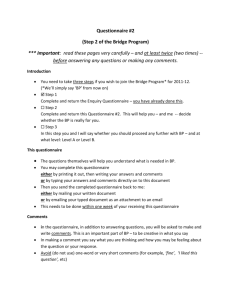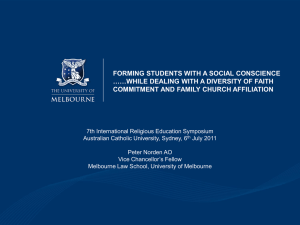ACU PRESS RELEASE * *vision in action* initiative
advertisement
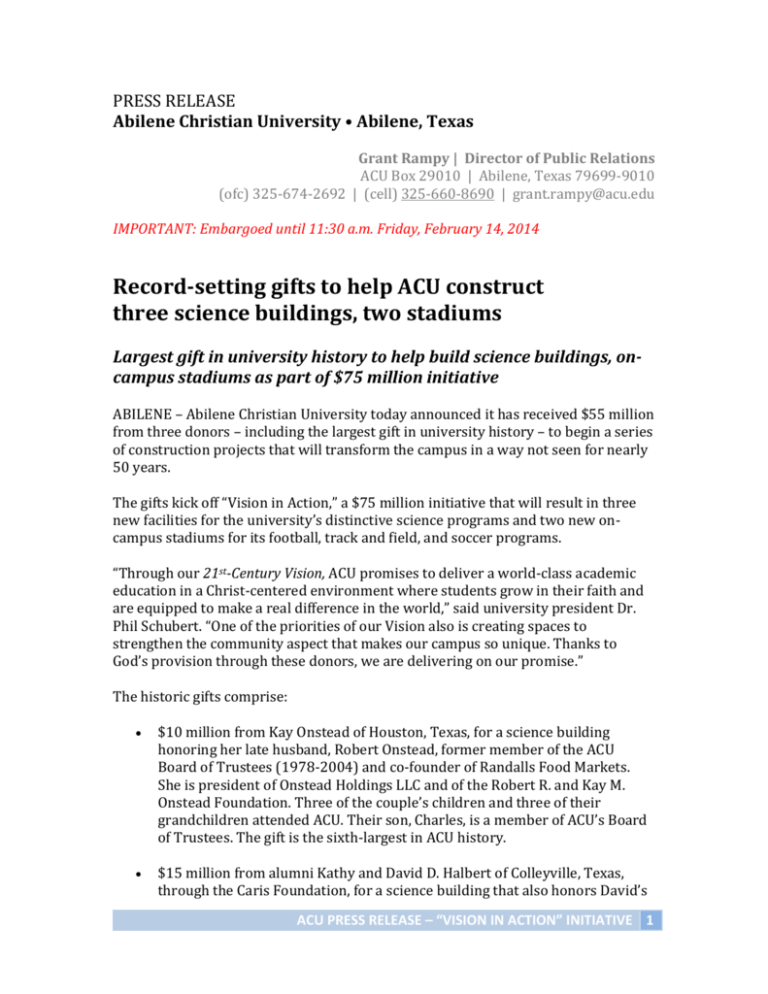
PRESS RELEASE Abilene Christian University • Abilene, Texas Grant Rampy | Director of Public Relations ACU Box 29010 | Abilene, Texas 79699-9010 (ofc) 325-674-2692 | (cell) 325-660-8690 | grant.rampy@acu.edu IMPORTANT: Embargoed until 11:30 a.m. Friday, February 14, 2014 Record-setting gifts to help ACU construct three science buildings, two stadiums Largest gift in university history to help build science buildings, oncampus stadiums as part of $75 million initiative ABILENE – Abilene Christian University today announced it has received $55 million from three donors – including the largest gift in university history – to begin a series of construction projects that will transform the campus in a way not seen for nearly 50 years. The gifts kick off “Vision in Action,” a $75 million initiative that will result in three new facilities for the university’s distinctive science programs and two new oncampus stadiums for its football, track and field, and soccer programs. “Through our 21st-Century Vision, ACU promises to deliver a world-class academic education in a Christ-centered environment where students grow in their faith and are equipped to make a real difference in the world,” said university president Dr. Phil Schubert. “One of the priorities of our Vision also is creating spaces to strengthen the community aspect that makes our campus so unique. Thanks to God’s provision through these donors, we are delivering on our promise.” The historic gifts comprise: $10 million from Kay Onstead of Houston, Texas, for a science building honoring her late husband, Robert Onstead, former member of the ACU Board of Trustees (1978-2004) and co-founder of Randalls Food Markets. She is president of Onstead Holdings LLC and of the Robert R. and Kay M. Onstead Foundation. Three of the couple’s children and three of their grandchildren attended ACU. Their son, Charles, is a member of ACU’s Board of Trustees. The gift is the sixth-largest in ACU history. $15 million from alumni Kathy and David D. Halbert of Colleyville, Texas, through the Caris Foundation, for a science building that also honors David’s ACU PRESS RELEASE – “VISION IN ACTION” INITIATIVE 1 grandparents, the late Dean and Thelma Walling. Dean Walling was an ACU trustee from 1976-83 and founding chair of the National Development Council during Design for Development campaigns that built numerous iconic buildings on the campus in the 1960s and ’70s. The Halberts cofounded the Caris Foundation to provide medical services to impoverished areas of the world. David Halbert was founder of AdvancePCS, one of the country’s largest pharmacy-benefits management companies before he sold it in 2004. Currently, he serves as chair and CEO of Caris Life Sciences. The Caris Foundation gift is the university’s third largest. All three of the Halberts’ children attended ACU. $30 million from alumni April and Mark Anthony of Dallas, Texas – the largest gift in ACU history, topping the $26.37 million received from the Grace L. Woodward Memorial Endowed Trust in 1998. The Anthonys’ commitment includes $15 million for construction of an on-campus football stadium; $7 million for ACU’s College of Business Administration, where both April and Mark studied; $5 million for a science building in honor of Robert R. Onstead; and $3 million in undesignated funds. A member of ACU’s Board of Trustees, April Anthony is CEO of Encompass Home Health and Homecare Homebase, both of which she founded. Mark Anthony is senior vice president for sales and marketing of Homecare Homebase, and is a founding board member of the Encompass Cares Foundation, which supports worldwide medical mission efforts. One of the Anthonys’ three children is an ACU student. Together, the gifts provide $30 million for a dramatic $45 million metamorphosis of the university’s science facilities, which will comprise three buildings. The HalbertWalling Research Center and the Robert R. Onstead Center for Science and Humanities will feature state-of-the-art laboratories, classrooms and offices supporting research and education for departments in the sciences and humanities. Bennett Gymnasium will be renovated into laboratory and classroom space for the university’s fast-growing engineering program. The Anthony gift provides $15 million toward Anthony Field at Wildcat Stadium on Ambler Avenue; upon its opening, a full season of Wildcat football will be played on the ACU campus for the first time since World War II. A separate project features a new stadium on Campus Court to be shared by the university’s legendary track and field program and its newer, though already successful, women’s soccer team. All facilities are projected to break ground this fall, pending completion of fundraising. They put into action the call of the university’s 21st-Century Vision, approved by the Board of Trustees in 2008. It states that “by 2020, ACU will become the premier university for the education of Christ-centered, global leaders,” and it promises, among other initiatives, that ACU will “enhance or build facilities related to the sciences” and “create additional community spaces across the campus.” 2 ACU PRESS RELEASE – “VISION IN ACTION” INITIATIVE The series of five projects – with the science buildings alone totaling more than 160,000 square feet – marks a dramatic change to the ACU campus not seen since the late 1960s, when McGlothlin Campus Center, Moody Coliseum, Gibson Health and Physical Education Center, and Brown Library were built, and Foster Science Building expanded. “We are here today as a university because generation after generation supported the consistent mission of ACU,” April Anthony said. “We’re excited to be part of that next generation to give back to a university that gave so much to us.” “These donors all have a legacy connecting them to ACU,” Schubert said, “and they are continuing that legacy by ensuring future generations of students have the facilities they need to pursue high-quality academics within a dynamic Christian community.” “They are the kind of amazing people you don't come across too often in life,” Schubert said. “They hold to unwavering standards of excellence while demonstrating uncommon humility and graciousness. In many ways, they reflect what we hope for every ACU graduate. I'm grateful for their friendship and for their passion to help push the university to a new level.” More details The facilities will replace two long-standing structures. The site of Elmer Gray Stadium, built in 1954, will become the site of the new football stadium, and Chambers Hall, one of the original buildings from the campus’ 1929 construction, will make way for the science facilities. Bennett Gymnasium was named for L.P. and Ruth Bennett, who gave 1,600 acres of ranch land to ACU in 1929, allowing Abilene Christian to construct what was then the largest gym between Dallas and El Paso; it opened during the 1929-30 school year. Bennett was an ACU trustee from 1940-56, and oil revenues from his family’s land produced millions of dollars for the university’s endowment through the years. Chambers Hall was named for E.D. Chambers and his wife, Julia, pioneer ranchers in West Texas who contributed to the building’s construction and later created the Chambers Trust. E.D. was an ACU trustee from 1929-45, and board chair from 194243. The Otto and Mattie Foster Science Building, which opened in 1946 and will become the Onstead Center, honored Otto, a pharmacist and visionary trustee from 1921-37 who proposed that ACU sell its original campus on North 1st Street and move to a more advantageous location. Gray Stadium’s namesake was Elmer J. Gray, who in 1932 became the first ACU track and field athlete to compete in the U.S. Olympic Trials. The sciences at ACU have a long and distinguished history dating to 1927, when Dr. Paul Witt – who later performed research that helped develop liquid sulfa drugs, the forerunners of modern antibiotics – formed the science department. ACU PRESS RELEASE – “VISION IN ACTION” INITIATIVE 3 The American Chemical Society has named the Department of Chemistry and Biochemistry an Approved Program for 42 consecutive years. More than 100 graduates have gone on to earn a Ph.D. in chemistry, and chemistry faculty have published more than 80 articles in peer-reviewed journals since 1980. ACU biology students are accepted into medical or dental school at a 90 percent rate – double the national average. And physics students and faculty are collaborators on three of the 10 most-cited papers on hadron physics published in the past decade. In 2012, ACU launched an engineering program, for which demand has nearly doubled expectations. More than 900 students currently major in at least one of the sciences represented by these new facilities. The new athletics facilities, meanwhile, will provide significant improvements for student-athletes and fans of three successful intercollegiate programs. Since the 1920s, Wildcat track and field and cross country teams have won 56 NCAA national championships and 124 league championships, while individual studentathletes have included 37 Olympians, claimed 21 world records, and won four Olympic gold medals. In 1999, Texas Monthly magazine named the ACU track and field program the Texas Sports Dynasty of the Century. ACU’s football program, meanwhile, has won national championships in 1973 and 1977, and 12 conference titles, the most recent in 2008 and 2010. Thirty-one Wildcats have gone on to play in the NFL, including four who were on active rosters in 2013. Football games were last played on campus at A.B. Morris Stadium from 1937-42, excepting a single game at Gray Stadium in 1958. The soccer program, begun in 2007, won the Lone Star Conference regular season championship in 2010 and the LSC tournament championship in 2011, while reaching the NCAA regional tournament both seasons. The program has a sterling .649 winning percentage since its inception. “Both stadiums will provide our student-athletes with some of the best facilities in which to compete and further develop their God-given talents,” said ACU athletics director Jared Mosley. “Along with a world-class, on-campus facility for our football team, we are excited to provide two of our most successful programs – one entering its eighth season, the other its 10th decade – with a state-of-the-art stadium that will better meet both of their needs.” To learn more about “Vision for Action,” see acu.edu/vision-in-action To learn more about ACU, see acu.edu 4 ACU PRESS RELEASE – “VISION IN ACTION” INITIATIVE
